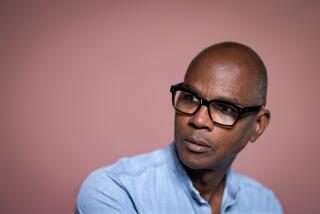Expert witness
- Share via
IN 1959, Mark Rothko proclaimed, “I hate and distrust all art historians, experts and critics. They are a bunch of parasites, feeding on the body of art. Their work not only is useless, it is misleading. They can say nothing worth listening to about art or the artist, aside from personal gossip, which I grant you can sometimes be interesting.” But Rothko (born Marcus Rothkowitz in 1903 in Dvinsk, Russia) did not actively resist writing about his own work. He just let his thoughts fall quietly -- in correspondence to friends, in notes to himself and to young students whom he felt would be more likely to understand what he was getting at. The perception of Rothko as an impassive Ozymandias of modern art was compounded by the fact that his published writings appeared in literary journals or far-flung newspapers. When his thoughts appeared in more mainstream publications, they were usually cranky letters to the editor in which he denounced pronouncements of his work and intentions. The impression this leaves is at best one of disinterest -- at worst, one of dismissal.
A sequel of sorts to 2004’s “The Artist’s Reality” -- a previously lost manuscript by Rothko from the early 1940s in which he reflects upon the limits of realism and migrates from rank formality toward abstraction without actually couching the evolution in terms of his own work -- “Writings on Art,” a compilation of 150 essays, notes to friends and patrons and exhibition catalog essays spanning the length and heft of his career from 1934 to the year before his death in 1970, collects these pieces for the first time.
As early as the 1934 essay “New Training for Future Artists and Art Lovers,” Rothko emphasizes the importance of a childlike simplicity in creation, much as did Matisse, to whom he dedicated his 1954 pastoral color-field work “Homage to Matisse.” His early writings examine not only his long-standing assertion that a child’s creativity “is usually lost before the child reaches the age of 12 and often earlier,” but also the equal importance of teachers -- not to impose aesthetic calcification but to act as guides and supporters. Rothko takes care to rescue painting from what he saw as a tortured fiction of stale representationalism, elevating emotions to the fore: He used colors, shades and gestures as moving evocations of mythology itself.
Rothko’s correspondence about his work fostered this idea of painting as a new form of language -- a communication that could be practiced as naturally as words and sentences. “I want to put you back in,” Rothko said of his aims to involve the viewer in the work. That he took various teaching positions over his career can be interpreted to mean that he worked to communicate this subtlety whenever possible.
After he suffered an aneurysm in 1968, his doctors ordered him not to paint works measuring more than 40 inches in height. For someone whose drives urged him to shed restriction -- witnessed in a 1957 letter to the editor of Art News firmly refuting Elaine de Kooning’s assertion that his work could be classified as “Action Painting” -- this was an irretrievably devastating regression.
“Writings on Art” becomes frustrating if only because one cannot discuss the ideas with its author. This relatively slim volume is equally invaluable because of the way these previously uncollected and in many cases unpublished words reveal a depth and development of character unique to the 20th century. Here is an artist embracing intangibles like myth in an era when the loftiest deities are revealed as the Joneses; here is an artist who demands his work command concentration and focus in a rapidly splintering world of noise and stimulation. Most of these texts come from a time during which Rothko developed his take on abstract expressionism. It’s easy to chart external reasons for an artist’s inspiration, but cataloging concrete inspiration from within is decidedly more difficult.
Rothko was always striving to illustrate humanity as made of something grandiloquent and serene and not of selfishness and empty holes. In a Harper’s interview, he denied the suggestion that he was a mystic : “I don’t prophesy the woes to come. I just paint the woes already here.” Son Christopher, writing in the preface to “The Artist’s Reality,” observes that, in that work, Rothko never uses the ego-bound pronoun “I.” This is like an author writing an entire novel without using the letter “e.” Rejection of ego is nearly impossible in modern memoir-culture, whose hallmark is the pressure for constant revelation. Removal of the ego from the work is itself an abstract art -- crystallized eloquently by the Rothko Chapel in Houston, in which 14 of his paintings hang for purposes of still contemplation. That Rothko’s name is on the chapel is immaterial. Ego doesn’t enter into it. His time is yours.
For someone who valued transcendence through art, no moment became more so than the day several of Rothko’s large-scale paintings arrived at the Tate in London -- accompanied by news of his death. A natural progression. To paraphrase Rothko’s words in the eulogy he gave for painter Milton Avery: Grieve for the loss of this great man, but rejoice for what he has left us. *
More to Read
The biggest entertainment stories
Get our big stories about Hollywood, film, television, music, arts, culture and more right in your inbox as soon as they publish.
You may occasionally receive promotional content from the Los Angeles Times.










